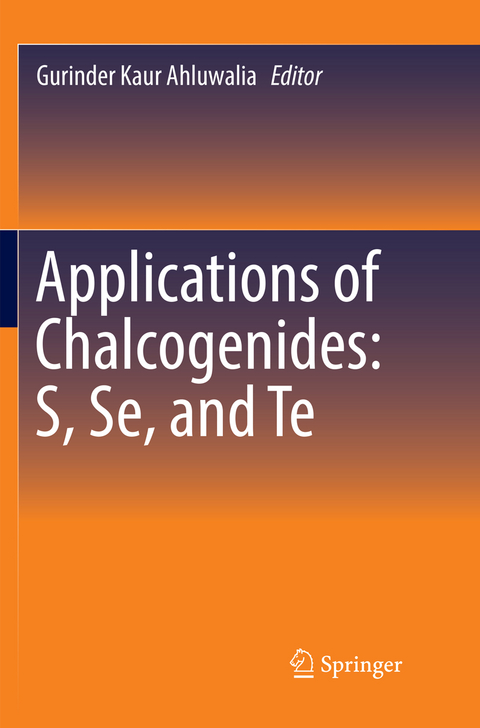
Applications of Chalcogenides: S, Se, and Te
Springer International Publishing (Verlag)
978-3-319-82289-1 (ISBN)
Gurinder Kaur Ahluwalia is a lead instructor at the Department of Physics at College of the North Atlantic (CNA), Labrador West Campus in Canada since August 2007. Gurinder received her PhD in Physics with specialization in amorphous semiconductors (chalcogenides) from the Department of Physics and Astrophysics at Delhi University in India in 1992. Thereafter she pursued active research on materials including chalcogenides and silicon at institutions across the globe. Coupled with 20+ years of professional experience in teaching and research, and more than 65 publications in international arena on investigation of novel materials as well as a book chapter on ‘Triblock Polymer Colloidal Nanoparticles”, Gurinder acquired top rated skills in sophisticated technologies such as; Synchrotron Beam line, Thin Film Technologies MBE, Photo-CVD, Thermal evaporation, Electron beam), Differential Scanning Calorimetry, UV-VIS-NIR Spectroscopy, Atomic force Spectroscopy, Electron Microscopies, Dielectric, Dark and photoconductivity measurements, cell designing for conductivity and dielectric measurements. Her Research Interests are focused on designing and investigation of novel materials for photovoltaics, non-linear optics devices, polymers, data Storage devices and biomaterials. Her research assignments include visiting professor at Institute for Molecular Science, Okazaki, Japan (1993), visiting scientist-University of Palermo, Italy (1993-1994), Monbusho postdoctoral fellowship-Toyohashi University of technology (1995-1996), visiting scientist (2003 and 2004)- Science University of Tokyo, JSPS (Japan Society for Promotion of Science) visiting professor (2003)-Osaka City University, Japan. She taught Physics at undergraduate and postgraduate levels at Delhi University (1992-1993) and Guru Nanak Dev University (GNDU) in Amritsar, India (1996-2005) and pursued research on materials, polymers and surfactants. In 2005 she moved to Canada along with her family and was accepted as a visiting scientist at the University of Western Ontario for two years. There she worked on second order non-linear properties using lasers and confocal microscopy and structural investigations of chalcogenides using the synchrotron facility at Canadian Light Source. At College of the North Atlantic, Gurinder teaches University Transfer courses and has established the first research Laboratory in the region of Labrador West - Materials and Nanotechnology Research Laboratory, with support from Provincial and Federal agencies and is pursuing research on design and development of materials and devices. Dr. Ahluwalia is an experienced researcher with a strong background of working in international and intercultural environment. She has been actively participating in international conferences and has served on organizing committees of several National and International events across Asia, Europe and North America. She is an active member of several international professional organizations, such as, Canadian Association of Physicists, Materials Research Society, Chalcogeniders Forum, American Ceramic Society and Life member- Semiconductor Society of India. On the non-academic front she pursues hobbies, such as, sports, music and visual arts. Along with her teaching tenure at GNDU, she organized Indo-Japanese concerts at the University and colleges in Amritsar.
Part I: Introduction.- Fundamentals of Chalcogenides in Crystalline, Amorphous and Nanocrystalline Forms.- Techniques for Structural Investigations (Theory and Experimental).- Nanostructured Chalcogenides.- Part II: Sulfur.- Optical Fibers.- Part III: Selenium.- Imaging and Detection.- Electrochemical Sensors.- Biomedical Applications.- Selenide Glass Fibers for Bio-Chemical Infrared Sensing.- Part IV: Tellurium.- Data Storage Devices.- Photovoltaics.- Infrared Detectors.
| Erscheint lt. Verlag | 23.6.2018 |
|---|---|
| Zusatzinfo | XIII, 461 p. 328 illus., 213 illus. in color. |
| Verlagsort | Cham |
| Sprache | englisch |
| Maße | 155 x 235 mm |
| Gewicht | 8202 g |
| Themenwelt | Naturwissenschaften ► Chemie ► Anorganische Chemie |
| Technik ► Elektrotechnik / Energietechnik | |
| Technik ► Maschinenbau | |
| Schlagworte | Amorphous Semiconductors • chalcogenides • Glasses in Electronics • Nanostructured Chalcogenides • Selenium Applications and Structure • Sulfur Application and Structure • Tellurium Applications and Structure |
| ISBN-10 | 3-319-82289-6 / 3319822896 |
| ISBN-13 | 978-3-319-82289-1 / 9783319822891 |
| Zustand | Neuware |
| Haben Sie eine Frage zum Produkt? |
aus dem Bereich


